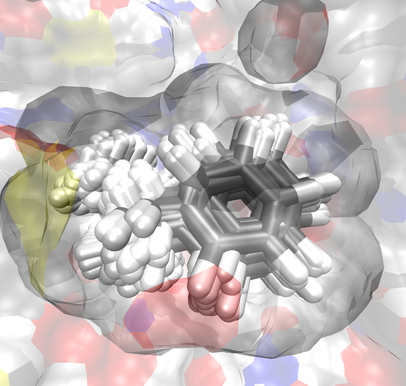Novel Free Energy estimation Methods with on-the-Fly Error Estimation

Bringing Clarity to the Prediction of Protein–Ligand Binding Free Energies via “Blurring”
We present a novel method to evaluate the free energies of ligand binding utilizing a Monte Carlo estimation of the configuration integrals concomitant with uncertainty quantification. Ensembles for integration are built through systematically perturbing an initial ligand conformation in a rigid binding pocket, which is optimized separately prior to incorporation of the ligand. The procedure producing the ensembles is called “blurring” and is carried out using in-house built code. The Boltzmann factor contribution of each pose to the configuration integral is computed and from there the free energy is obtained. Potential function uncertainties are estimated using a fragment-based error propagation method. This method has been applied to a set of small aromatic ligands complexed with T4 Lysozyme L99A mutant. Microstate scoring has been carried out with the ff99SB, ff94, and PM6DH2 functionals in conjunction with continuum solvation models like Generalized Born (GB), Conductor-like Screening Model (COSMO), and SMD. Especially PM6DH2 scoring has yielded a binding free energy estimate which is in good correlation to the experimental binding affinities (R2=0.7) whereas the calculated binding free energies have been underestimated with all methods. We suggest this is due to the single static protein structure and inaccuracies in the solvent models we have employed.
We present a novel method to evaluate the free energies of ligand binding utilizing a Monte Carlo estimation of the configuration integrals concomitant with uncertainty quantification. Ensembles for integration are built through systematically perturbing an initial ligand conformation in a rigid binding pocket, which is optimized separately prior to incorporation of the ligand. The procedure producing the ensembles is called “blurring” and is carried out using in-house built code. The Boltzmann factor contribution of each pose to the configuration integral is computed and from there the free energy is obtained. Potential function uncertainties are estimated using a fragment-based error propagation method. This method has been applied to a set of small aromatic ligands complexed with T4 Lysozyme L99A mutant. Microstate scoring has been carried out with the ff99SB, ff94, and PM6DH2 functionals in conjunction with continuum solvation models like Generalized Born (GB), Conductor-like Screening Model (COSMO), and SMD. Especially PM6DH2 scoring has yielded a binding free energy estimate which is in good correlation to the experimental binding affinities (R2=0.7) whereas the calculated binding free energies have been underestimated with all methods. We suggest this is due to the single static protein structure and inaccuracies in the solvent models we have employed.
